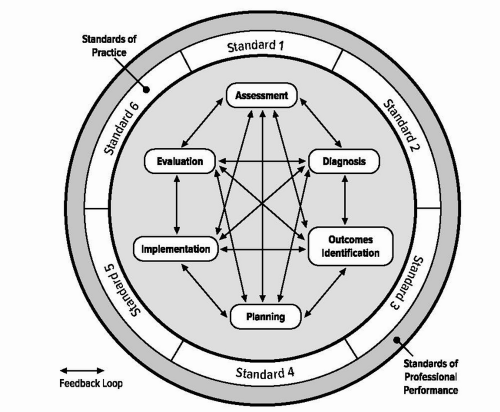Scope of Nursing Practice
Ann O’Sullivan MSN, RN, CNE, NE-BC
Overview of Scope of Nursing Practice
As discussed in chapter 1, the definition of nursing, according to the American Nurses Association (ANA, 2010a, p. 6), serves as the foundation for and is integral to understanding the details presented in Nursing: Scope and Standards of Practice, 2nd edition (ANA, 2010b).
A professional nursing organization has a responsibility to its members and to the public it serves to develop the scope and standards of its profession’s practice. As the professional organization for all registered nurses, the American Nurses Association (ANA) has assumed the responsibility for developing the scope and standards [with broad input from the profession] that apply to the practice of all professional nurses and serve as a template for nursing specialty practice. (ANA, 2010b, p. 1)
The scope of practice statement published by the ANA builds on that definition of nursing to succinctly and comprehensively describe the “who,” “what,” “where,” “when,” “why,” and “how” of nursing practice. Each of those questions must be sufficiently answered to provide a complete picture of the dynamic and complex practice of nursing and its evolving boundaries and membership. The profession of nursing has one scope of practice that encompasses the full range of nursing practice. The depth and breadth in which individual registered nurses engage in the total scope of nursing practice depends on their education, experience, role, and the population served (ANA, 2010b, p. 2).
All nurses must understand what scope of practice means and must have the autonomy to practice to the full extent of their nursing license. The importance of scope of practice was identified as a key message in the Institute of Medicine’s Future of’Nursingreport (IOM, 2011; p. 5): “Regulatory barriers are particularly problematic. Regulations defining scope-of-practice limitations vary widely by state. As a result, what advanced practice registered nurses are able to do once they graduate varies widely for reasons that are related not to their ability, education or training, or safety concerns, but to the political decisions of the state in which they work”. The report makes a bold recommendation to “Remove scope-of-practice barriers. Advanced practice registered nurses should be able to practice to the full extent of their education and training. Specific actions are suggested for how to accomplish this recommendation” (IOM, 2011; p. 271). Although this recommendation primarily addresses the scope of practice for nurse practitioners, all nurses should practice to the full extent of their scope of practice.
Nursing Process
The nursing process, a key framework for nursing, is the method for carrying out the scope of practice by the professional nurse. It relies heavily on feedback loops among the components of the process: assessment (Standard 1), diagnosis (Standard 2), outcomes identification (Standard 3), planning (Standard 4), implementation (Standard 5), and evaluation (Standard 6), as illustrated in Figure 2.1. The nursing process is used in both clinical and nonclinical settings and practice roles.
In the clinical setting, the nurse on a surgical unit uses the nursing process feedback loop in caring for a patient who is in pain after surgery. After providing pain treatment, the nurse reassesses the patient’s pain to determine whether the treatment has relieved the pain. If the pain is not relieved or controlled, the nurse continues to assess, to develop outcomes, and to plan and implement new measures to control the pain. The nurse continues to reassess and evaluate those measures with the patient until the patient’s pain is under control.
In nursing education, the instructor uses several assessment tools and processes to identify a student’s knowledge, skills, and abilities in a specific area of nursing practice. The instructor identifies outcomes according to the specific content and the student’s level of experience and education. Next, the instructor develops and implements plans to meet identified outcomes and then reassesses periodically through testing, clinical observation, and discussions with the student. Drawing on further assessments, plans, and implementation, the instructor may revise strategies. Evaluation is ongoing.
 Figure 2.1. Nursing Process and the Standards of Professional Nursing Practice (ANA, 2010b, p. 3) |
Characteristics of Nursing Practice
ANA’s discussion of the Scope of Nursing Practice identifies tenets of professional nursing practice (ANA, 2010b, pp. 4-5). A tenet is an axiomatic principle or belief generally held as true, usually in the context of an organization, profession, or other such group. The five tenets of professional nursing practice are as follows:
Stay updated, free articles. Join our Telegram channel

Full access? Get Clinical Tree


